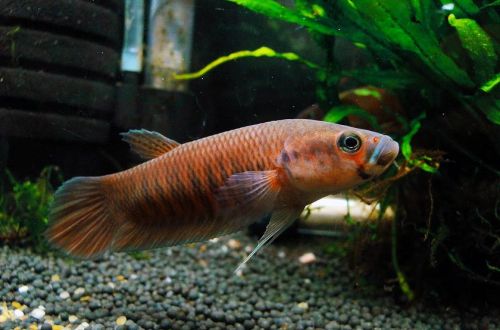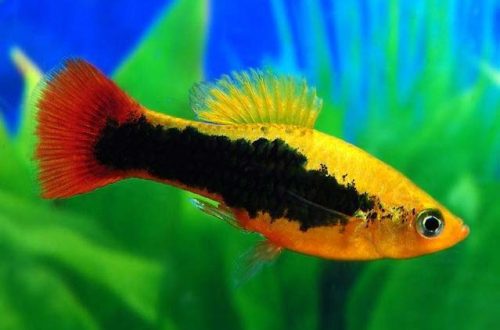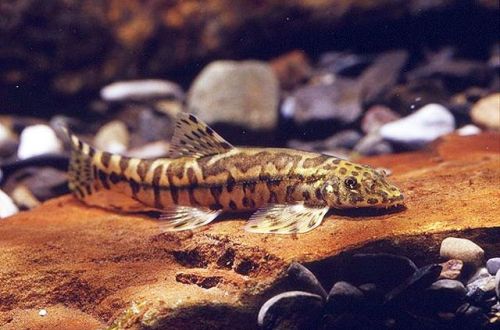
Betta Pathoti
Betta patoti or Cockerel patoti, scientific name Betta patoti, belongs to the Osphronemidae family. Belongs to the group of fighting fish and has a difficult disposition towards relatives. Difficulties for the novice aquarist will also bring some features when keeping in terms of water treatment. Not recommended for beginners.

Contents
Habitat
It comes from Southeast Asia from the Indonesian part of the island of Borneo. Found in the river systems of East Kalimantan province. A typical biotope is a shallow forest stream or river, the bottom of which is covered with a layer of fallen leaves, branches and numerous snags. The water has a brownish tint due to the high concentration of tannins formed as a result of the decomposition of plant organic matter.
Brief information:
- The volume of the aquarium – from 70 liters.
- Temperature – 21-27°C
- Value pH — 4.0–7.0
- Water hardness – 0–10 dGH
- Substrate type – any dark
- Lighting – subdued
- Brackish water – no
- Water movement – little or no
- The size of the fish is 9–10 cm.
- Food – any food
- Temperament – conditionally peaceful
- Content – in a pair of male / female or with several females together with other species
Description
Adults reach a length of 9–10 cm. The fish has an elongated muscular body. Color varies from black to dark red. Males, unlike females, are somewhat larger and have enlarged fins.
Food
It belongs to carnivorous species, in nature it feeds on small insects and other zooplankton. In the home aquarium, they are accustomed to alternative foods. The daily diet may consist of dry, frozen and live foods popular in the aquarium hobby. A good choice would be specialized food for Betta fish, produced by many manufacturers.
Maintenance and care, arrangement of the aquarium
The optimal size of the aquarium for one pair of fish starts from 70-80 liters. In the design, it is desirable to recreate an environment reminiscent of the natural habitat of this species. Namely: a subdued level of illumination or diffused light, dark ground with areas of dense aquatic vegetation, shelters in the form of flooded snags. The dried leaves of some trees, soaked and placed on the bottom, will be a great addition. They perform not only the functions of a natural decor, but also serve as a means of giving water a characteristic chemical composition, releasing humic acids and tannins during decomposition. Read more in the article “Which tree leaves can be used in an aquarium.”
Successful long-term management of Patoti cockerel depends on providing a stable aquatic environment within an acceptable range of temperatures and hydrochemical values (low pH and dGH). The biological balance in a closed aquarium ecosystem is determined by the regularity of mandatory maintenance procedures (partial water changes, waste disposal, etc.) and the smooth operation of the installed equipment.
Behavior and Compatibility
Intraspecific relationships are built on a hierarchy between strong and weak individuals. Males compete with each other for position in the hierarchy and the attention of females. In a small aquarium, fierce skirmishes between them are not uncommon. In small tanks, it is recommended to keep only one male in the company of one or more females. Peacefully tuned in relation to other species. They get along well with non-aggressive fish of comparable size, able to live in similar conditions.
Breeding / breeding
Betta patoti, like some other fighting fish, carry fertilized eggs in their mouths until they hatch. This breeding strategy makes it possible to secure the brood at the most vulnerable stage of development. Males are engaged in gestation, collecting eggs in their mouths and secluding themselves in a quiet corner of the aquarium or in some kind of shelter. It is important that no one bothers him, for example, other males or overly active neighbors, otherwise he may release the eggs prematurely or completely accidentally swallow them. The incubation period lasts 12–17 days, after which fully formed fry appear.
It is worth noting that the male forms a temporary pair only with the female with whom he has been in the same aquarium for a long time or grew up together. If you simply settle together heterosexual individuals purchased at different pet stores or sellers, then most likely you will not be able to get a pair. Moreover, the male will be very hostile to his new companion. Therefore, breeding is only possible in an established Betta group.
Fish diseases
The cause of most diseases is unsuitable conditions of detention. A stable habitat will be the key to successful keeping. In the event of symptoms of the disease, first of all, the quality of the water should be checked and, if deviations are found, measures should be taken to correct the situation. If symptoms persist or even worsen, medical treatment will be required. Read more about symptoms and treatments in the Aquarium Fish Diseases section.





